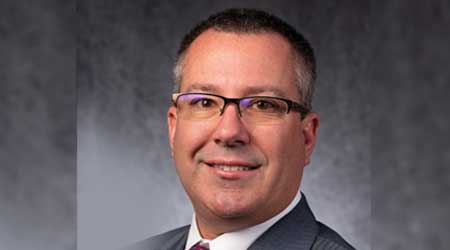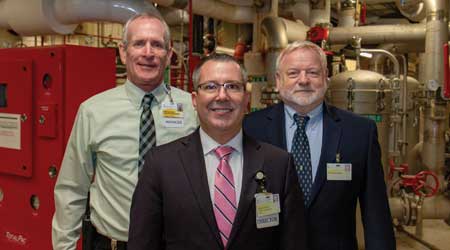 Richie Stever, director of operations and maintenance at the University of Maryland Medical Center (UMMC) is effectively managing a mass vaccination site and a 3.5-million-square foot hospital simultaneously.
Richie Stever, director of operations and maintenance at the University of Maryland Medical Center (UMMC) is effectively managing a mass vaccination site and a 3.5-million-square foot hospital simultaneously.Lessons Learned from Managing a Mass Vax Site
Managing a mass vaccination site has provided valuable lessons for when he returns to his "day job" of managing facilities for a huge hospital system.
What impact has Richie Stever had on UMMC and the COVID-19 efforts in the hospital facility and at the M&T Bank Stadium’s mass vaccination site? Thanks to Stever and his team, UMMC has been able to provide safe care to patients, families and the community during this global pandemic.
UMMC was prepared and responsive well before the first COVID-19 cases, Solis says. Stever and his team, along with other leaders from life safety, in-house construction, environmental services, supply chain, clinical engineering, emergency management, and providers and nurses, created biocontainment units and expanded negative pressure capabilities within the hospitals. They also planned and built a modular care unit off-site for critical-care COVID-19 patients. And most recently, they opened the mass vaccination sites for staff, patients and community. This includes sites within the hospital, the University of Maryland Baltimore, and now in M&T Bank Stadium, which has the capacity to vaccinate 6,000 patients per day.
“Richie exemplifies top-quality in leadership, and I am very fortunate to work with him,” Solis says.
Lt. Colonel Charles Wetzelberger, Maryland National Guard and deputy site coordinator at the M&T Bank Stadium mass vaccination site, works alongside Stever as part of the site’s leadership team.
“Richie is a creative visionary with an added — and crucial — ability to partner with others to make a vision become real,” Wetzelberger says. “And I think that is really exemplified by the M&T Bank Stadium mass vaccination site. Working with Richie and all our partners at the University of Maryland Medical System, the Maryland Department of Health, and the Maryland Stadium Authority, we were able to transform the stadium into a mass vaccination site in just 18 days.”
Wetzelberger points to Stever’s eagerness to be a working supervisor as Stever’s key attribute.
“He’s not afraid to get his hands dirty and break a sweat,” Wetzelberger says. “He’s also open-minded with a keen eye for continuous process improvements. At the M&T Bank Stadium mass vaccination site, Richie’s operational acumen and commitment to continuously refining processes are helping to get more people vaccinated. That’s a pretty direct impact.”
On the horizon
When the COVID-19 pandemic is over, Stever will return to his role as director of operations and maintenance with the hospital system. How does he see all the experiences he’s had establishing and overseeing a mass vaccination site impacting his previous role?

(Stever and his team work hard to foster a fun work environment. “Happier staff means happy patients and guests,” he says.)
“For me, prior to COVID, I didn’t have much personal experience with the overall patient experience,” he says. “I knew the building and all of its components as it related to the patient experience, but now in this operational role as operations chief, I’m closer to the patient now than I have been in the past. I’m actually looking at and listening to the interactions between staff vaccinators and the patients. I evaluate things like how long it took for the patient to go through the vaccination process. It has provided me with a higher level view of what it takes to move patients through the process and how their experiences were.”
While the focus on the patient experience will be at the forefront of Stever’s role long after the pandemic has passed, he also continually embraces key best practices that he shares with his team — best practices that are appropriate regardless of any health crisis.
“COVID aside, there have been several best practices that I’ve focused on personally and with my team,” Stever says.
First, Stever focuses on sustainability as it pertains to waste as well as energy efficiency in building operations. He’s also very concerned about the staff he works with and the progression in their careers.
“I am focused on finding career ladders for the staff and providing opportunities and training,” Stever says. “These are the kinds of things that get me excited, especially when I see somebody learning more and gaining more responsibility. We offer an apprenticeship program allowing individuals who may know very little about a certain role or task to eventually completely grasp the concepts involved. Seeing this type of personal growth in others is what really drives me.”
One key piece of advice Stever tries to instill in others in the field is to continue to study and learn their craft. He also stresses the importance of getting involved with various organizations in healthcare facilities management. Being involved in these groups can move people forward in their career.
“And remember that there’s a lot of people out there who are willing to lend a hand,” he says. “In fact, there are so many facility managers out there who have seen the issue you may be dealing with and can help you through it. Remember you aren’t stuck on an island. I work for a large facility, and I have a lot of people around me who can help. But for those in smaller facilities, they may not have the support or expert knowledge in their immediate environment. They do have it elsewhere in the country, including online communities who can help facilities managers and building operators to solve the problems.”
Facility management isn’t a glamorous profession, and dealing with the COVID-19 pandemic can create additional stress. But through it all, Stever tries to foster a fun work environment.
“We work hard, don’t get me wrong,” he says. “But it’s a lot easier working hard when you are having fun doing it. Happier staff means happy patients and guests, so that’s how I try to live. I’ve seen the devastation that COVID has had on people, particularly early in the pandemic when there were a lot of patients lying in the hospital beds with tubes everywhere. I certainly don’t want anyone that I care about to be in that position. So it gives me a lot of pleasure with the vaccination site, seeing how appreciative people are to us for setting up the site and giving them the shot. Pushing a lot of people through this process and getting them the vaccination quickly is rewarding.”
People queuing up at the mass vaccination site frequently tell Stever how they haven’t been out of the house since February 2020.
“They are appreciative to see the level of precautions we have provided, and it makes them feel very comfortable,” Stever says. “This vaccination site is the light at the end of the tunnel. I’m looking forward to going back to life as it was, although clearly it is not going to be the same. But if we can get to three quarters of the way it was, that would be great.”
Maura Keller is a Twin Cities-based writer and editor.
Related Topics:














